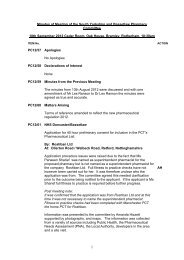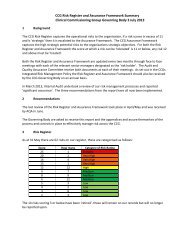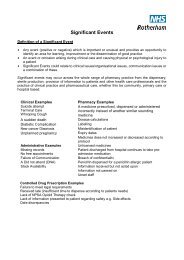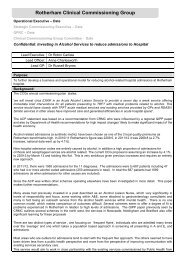Common Warts And Verruca - Rotherham CCG
Common Warts And Verruca - Rotherham CCG
Common Warts And Verruca - Rotherham CCG
You also want an ePaper? Increase the reach of your titles
YUMPU automatically turns print PDFs into web optimized ePapers that Google loves.
Date Ratified: 03 December 2008 updated November 2012<br />
13.7 Preparations for warts and verruca<br />
Salicylic acid<br />
Condition definition<br />
Cutaneous warts (common warts, verruca vulgaris) are small, rough skin-coloured<br />
lesions affecting the epidermis of the skin and caused by infection with human papilloma<br />
virus (HPV). HPV infects epithelial cells and viral replication results in proliferation of the<br />
cells with the formation of the typical warty papule or plaque. The clinical appearance of<br />
warts is variable and depends to some extent on the type of HPV involved and the site of<br />
infection.<br />
<strong>Warts</strong> are diagnosed from their typical appearance:<br />
<strong>Common</strong> warts: firm and raised with a rough surface that resembles a cauliflower<br />
(common on knuckles, knees, and fingers).<br />
Plane warts: round, flat topped, and yellow (common on the backs of hands).<br />
Filiform warts: long and slender (common on the face and neck).<br />
Plantar warts (verrucae): grow on the soles of the feet; they often have black dots in the<br />
centre and may be painful.<br />
Mosaic warts occur when palmar or plantar warts coalesce into larger plaques on the<br />
hands and feet.<br />
To view images of skin conditions www.dermis.net<br />
Molluscum contagium (a self-limiting condition) can be confused with common warts and<br />
presents as white umbilicated papules, often with a central depression.<br />
<strong>Warts</strong> may regress on their own and treatment is required only if the warts are<br />
painful, unsightly, persistent or cause distress.<br />
Who can be treated under this protocol<br />
Patients aged over 2 years with a wart or verruca on the hands or feet which matches<br />
the above conditions for treatment.<br />
When to advise patients to contact their GP<br />
Immuno-compromised/suppressed patients (sudden appearance/large numbers)<br />
Bleeding of the growth.<br />
Itching in the area of the growth or on the growth itself.<br />
<strong>Warts</strong> other than those on the hands or feet.<br />
Change in the appearance of the growth with change of size or colour.<br />
Multiple warts covering large areas.<br />
Failure of previous over the counter treatment following three months of an<br />
appropriate treatment.<br />
Review Date: 02 December 2010 updated November 2012
Date Ratified: 03 December 2008 updated November 2012<br />
Children under 2 years of age.<br />
Patients with diabetes<br />
Recommended Treatments<br />
First choice – No treatment<br />
Second choice – Salactol® Paint<br />
Third choice – Occlusal® Cutaneous Solution<br />
See BNF for further details on Salicylic acid preparations<br />
Treatment selection criteria<br />
For most people there is a strong case for not treating warts or verrucae.<br />
<strong>Warts</strong> do not usually cause symptoms.<br />
Most warts resolve spontaneously within months or, at the most, within 2 years.<br />
Treatment may be prolonged and can have adverse effects.<br />
Cryotherapy requires several clinic visits, can be painful at the time of application,<br />
and may cause pain, blistering, infection, and depigmentation.<br />
Topical salicylic acid may require administration for up to 12 weeks and can cause<br />
local skin irritation.<br />
Consider treatment if:<br />
The wart is painful (for example on the soles of the feet or near the nails).<br />
The wart is cosmetically unsightly<br />
The wart is persisting.<br />
N.B. Occlusal® should only be used in patients with a known allergy to colophony which<br />
is contained in the second choice preparation. It is wise to use the third choice product in<br />
patients who are allergic to elastic adhesive plasters.<br />
Counselling points<br />
Although warts can be cosmetically unsightly, they are not harmful; usually they<br />
do not cause symptoms, and resolve without treatment.<br />
<strong>Warts</strong> are contagious, but the risk of transmission is thought to be low.<br />
Some swimming pools/sports centres will require children to wear verruca socks.<br />
Advice should be sought from the leisure centre, but children should not be<br />
discouraged from participating in activities. However, it is sensible to consider<br />
measures to reduce the risk of transmission:<br />
o Cover the wart with a waterproof plaster when swimming.<br />
o Wear flip-flops in communal showers.<br />
o Avoid sharing shoes, socks, or towels.<br />
Treatment must be applied daily and can typically take up to three months or<br />
longer for the wart to clear. The majority of warts clear within 2 years.<br />
Once or twice a week, rub off the dead tissue from the top surface of the wart<br />
with a suitable nail or foot file reserved for this purpose.<br />
Soak the affected area in warm water for five minutes prior to applying the<br />
treatment.<br />
Review Date: 02 December 2010 updated November 2012
Date Ratified: 03 December 2008 updated November 2012<br />
Counselling points cont.<br />
Protect the surrounding skin by applying the treatment carefully or cover the<br />
surrounding area with petroleum jelly or a plaster designed for the purpose. If the<br />
application becomes painful, treatment should be withheld for a few days then<br />
recommenced.<br />
Never apply the treatment to any area of the body other than the hands or feet.<br />
Occlusion of the wart may help with treatment and so it may help to cover the<br />
wart with a plaster especially if the patient considers the wart to be unsightly.<br />
Limit personal spread (auto-inoculation) by:<br />
o Avoiding scratching lesions.<br />
o Avoiding biting nails or sucking fingers that have warts.<br />
o Keeping feet dry and changing socks daily.<br />
Patient Information Leaflet from patient.co.uk to be supplied.<br />
http://www.patient.co.uk/health/<strong>Warts</strong>-and-<strong>Verruca</strong>s.htm<br />
Further Information from NHS Choices<br />
http://www.nhs.uk/Pages/HomePage.aspx<br />
Review Date: 02 December 2010 updated November 2012

















